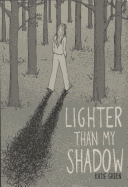
Katie Green's graphic novel memoir, Lighter Than My Shadow, is a heavy book, both literally and figuratively. Simply holding the paperback gives the reader an idea of what is to come--the 500-plus pages of this illustrated novel are hefty paper stock, the book a significant weight in the hands of the reader before it has even been opened. Marketed with adult graphic novels in the U.K., Green's story is about as weighty as it can get: a young girl, diagnosed with anorexia, battles herself and her addiction and is eventually abused by a sexual predator. The reading experience is painful and exhausting as the protagonist repeatedly tries (and fails) to quell her illness and gain control of herself.
Katie's problems with food began at a very young age. Mealtimes were tough at home: her parents would scold her for not eating and would force her to finish everything on her plate. Eating was "even more difficult at school." Her friends would all finish before her and leave her alone, an easy target for bullies and for her own unhealthy thoughts. A brief stint of family counseling helped with the disordered eating for a while, but when puberty hit, Katie's body issues increased and she began bingeing to deal with the pressures of bullies and her changing body. She remained thin, and her friends noticed:
"I wish I could be anorexic... to be able to just not eat if I wanted to."
"You'd never have the willpower."
"Hehe no, look at me! I'd do anything to be skinny like Katie."
Katie began comparing her body to others--"they all seemed so perfect.... skinny... curvy... sporty..."--and saw her own body as out of proportion.
One Lent during high school, Katie and her friends gave up junk food. This was a turning point for her; she felt "healthy. Clean and light." When Lent was over, she and her friends binged on all the junk they had denied themselves; the eating made Katie feel heavy, obese. The author depicts her post-Lent binge as Katie surrounded by a mess of black scribbles with a protruding stomach and thick thighs, both of which she cuts clean off with a meat cleaver.
The illustrations of eating get darker and darker, Katie's throat coated in black scribbles, the dark haze flowing down to her stomach. This same black cloud follows her from room to room as it sits inside her. She is shown being ripped apart by the perceived unhealthy food until she eventually reaches a hand down her throat to pull the blackness out. But her attempts at purging were never successful.
The disordered eating got worse as she began to use food as a reward: "One bite each time" she finished a page of homework. It was "better still," though, if she didn't "eat it at all." Katie ate less and less, wanting to fade away, fighting with her family as they tried to help, until she finally found herself in the hospital. Her recovery work began in earnest after her release: she went to therapy; her parents monitored her food; she stayed at home.
But when she went back to school, the disordered eating took hold again. Eventually, Katie sought nontraditional help and was hooked up with a therapist, Jake, who worked "with stuck energy in the body." Slowly, through session after session of touch therapy in his tent, Jake made Katie feel stronger and healthier. But as he built her up, he tore down her other relationships, asking her why she let her parents run her life, why she let them speak for her. Although Katie began to feel like she was getting better, the illustrations make it clear that she was still fighting the disordered eating--still surrounded by the black cloud, and being misled by an older man in a position of power.
As she started college, Katie continued to limit her intake, did yoga frequently and kept in touch with Jake. When she met a potential partner, Jake suggested her relationship with the young man was unhealthy, that he was controlling her. When Katie tried to have sex with the young man, the darkness came in as strongly as it ever had--and she broke up with him, at Jake's urging. It was only after this experience that she realized Jake had been sexually assaulting her when she went in for "treatment." All of the work she had done--all of the strength she thought she had gained--felt like a lie. She thought her entire recovery was a lie.
And so Lighter Than My Shadow goes. Katie makes steps in her recovery only to find herself limiting her intake. She feels strong but is unable to stop herself from bingeing. Over and over, Katie makes progress, only to trip and fall along the way. The black-and-gray illustrations (with occasional splashes of color) set the tone and mood, depicting the bleakness of living with an eating disorder and the pain of uncovering abuse. The black scribbles are a constant; they stream out of a crevice in her head, they encroach upon her space. They take over one page, then another and another, until there is only darkness. Anyone even remotely familiar with addiction will recognize the immense frustration and weariness with oneself that comes with this process--and anyone who reads this book, addiction or no, has no choice but to experience the malaise along with Katie. The outcome is ultimately positive--Katie's recovery steadies and evens out by the end of the work--but Lighter Than My Shadow depicts the road to recovery with extreme precision and care. It is tedious. It is painful. It is triggering. It is frustrating. It is recovery. --Siân Gaetano

